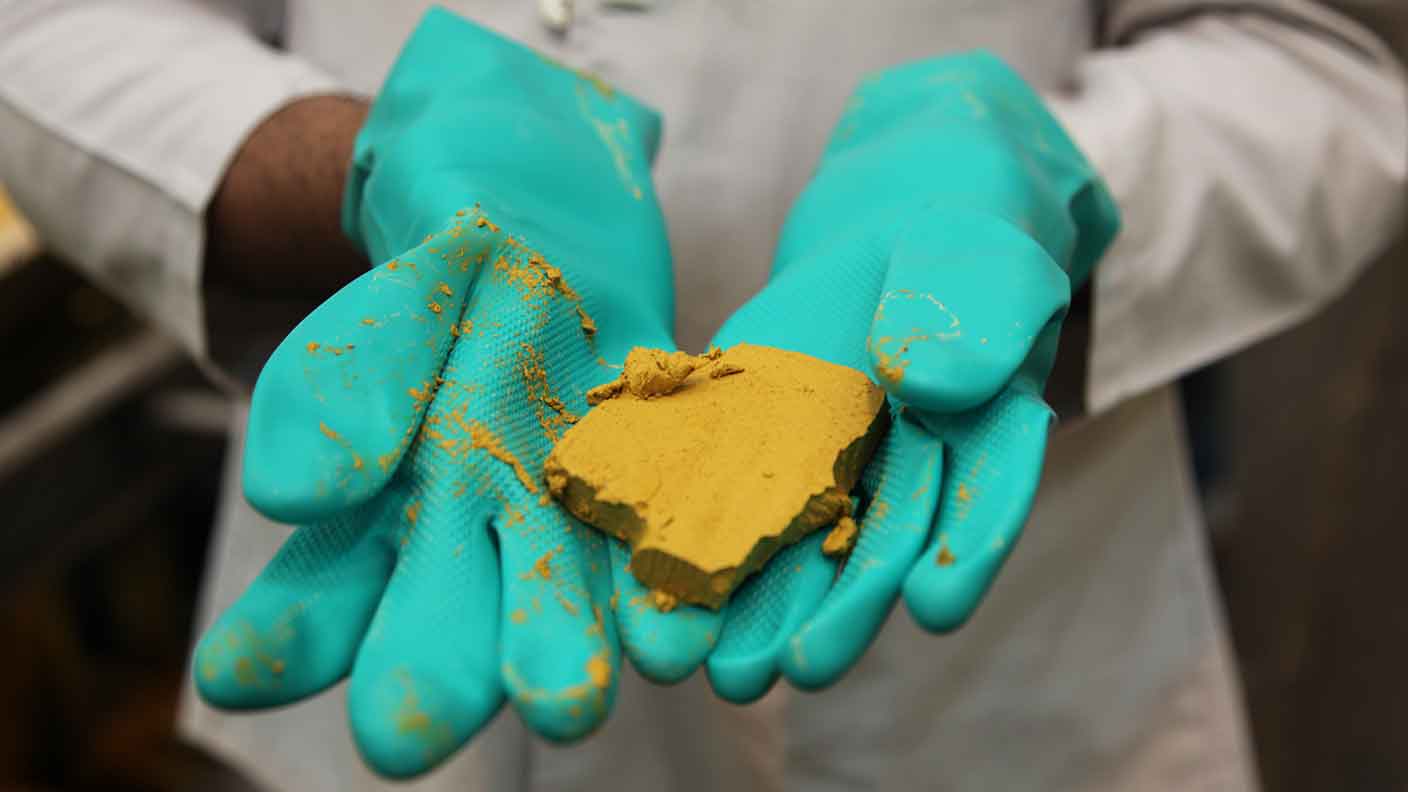The uranium price is finally on the rise – here’s the easiest way to bet on a bull market
The uranium price has been quietly creeping up to hit a four-year high. Dominic Frisby explains what’s behind the rise, and picks the best way to invest.


Stocks have crashed then rallied. People are falling over each other to buy government bonds. Gold is at seven-year highs. Oil has capitulated. Industrial metals are rebounding. Oh, my goodness the noise!
And yet there is one essential strategic metal – uranium – that has quietly, discreetly crept to four-year highs. I believe it’s worthy of your attention.
The uranium market has just experienced a huge supply shock
Stealth bull markets are the best kind of bull markets. Nobody mentions them. The media aren’t on board yet. The story hasn’t broken, and yet the asset in question creeps upwards. We could be in the early stages of one of those.
MoneyWeek
Subscribe to MoneyWeek today and get your first six magazine issues absolutely FREE

Sign up to Money Morning
Don't miss the latest investment and personal finances news, market analysis, plus money-saving tips with our free twice-daily newsletter
Don't miss the latest investment and personal finances news, market analysis, plus money-saving tips with our free twice-daily newsletter
I stress the word “could”. There have been plenty of false dawns. But a supply shock has long been forecast, and it may finally be here. Today we consider uranium.
Covid 19 or not, there is no shortage of demand for electricity, nor is there likely to be, and, for all the investment that has gone into clean energy, fossil fuels still account for more than 65% of world electricity demand. Hydro power accounts for 16%, wind and solar about 6%. And nuclear power comes in at 10%.
China is by far and away the world’s largest electricity consumer. For those of you that like your stats, its electricity generation came in at 7.3 PWh (that’s petawatt hours) last year. The US comes in second at around 4 PWh.
On a per head basis, the world’s largest consumer of electricity is not, as you might have expected, the US, but Iceland. It kind of makes sense when you think about it: it’s cold there and power is cheap. Hot on the heels of Iceland come Liechtenstein, Norway, Kuwait and Bahrain.
Around 69% of China’s electricity is generated by burning fossil fuels, mostly coal. Air pollution is a major problem. Nuclear power is part of the solution, although it currently only accounts for 4% of its electricity generation. That 4% comes from the 45 nuclear power reactors that are now operating (increasing to 56 this year, it is hoped).
China’s stated goal – and it has a habit of meeting its goals – is that by 2050 that 4% figure will be 28%. That is a big uptake.
In the US, on the other hand, around 20% of its electricity is already nuclear generated. So there is no shortage of long-term demand.
So to supply. The world’s largest producer is Kazakhstan (40% of global supply), followed by Canada (13%), Australia (12%) and Namibia (10%). The world, then, depends on four countries for 75% of its supply. Indeed, something like 65% of global supply comes from just six mines. This represents an extremely vulnerable situation.
Kazatomprom is Kazakhstan’s national operator and the world’s largest uranium producer. It announced last week that all uranium mines in Kazakhstan will cease production for three months to slow the spread of the virus. Kazakhstan’s major cities, meanwhile, are in lockdown.
The week before, Canada’s Cameco said it was closing Cigar Lake, the world’s largest uranium mine, for at least four weeks, following directives from the Canadian and Saskatchewan provincial governments. Other North American operations are similarly mothballed. Denison Mines, for example, has suspended the environmental assessment for its Wheeler River uranium project.
Namibia, another key supplier of uranium to China, has also closed down all mining until the virus comes under control. Its vast Rossing mine is operated by a state-owned Chinese company. (If you think things are tough here in Europe, 25% of Namibia’s national income comes from mining and the whole industry has been put on hold).
Australia, which has not been hit as hard by Covid-19 as elsewhere, suddenly finds itself under the scrutiny of the uranium investment world. Its uranium junior mining companies have been going bananas.
The easiest way to invest in uranium
So is this a new bull market, or is this a temporary situation brought on by Covid? That’s the question. The fact is that the market was always vulnerable to a supply shock and now we have it.
The uranium price has been locked in the $24-$26/lb range for about a year, but this last fortnight it has broken up to $31/lb – three-year highs.
That’s promising, but we have a long way to go to get back to the 2006 highs above $140/lb, when uranium mania swept the world.
One way to play this is to speculate in uranium mining companies. “But what is the point buying a company whose operations are currently suspended or about to be suspended?” you may ask – and I tend to agree. Suspended operations can drain capital fast (though bailouts may come).
Those companies whose mines are at the exploration or development stages may see better gains as the values of their ore bodies are being re-rated, but it’s not like a great deal of development can take place until further notice.
So the safest way to play this (to avoid operational risk) is to play the spot price of the metal itself. It’s far less racy, but your risk is lower. London-listed Yellowcake Plc (LSE: YCA) has been set up with this purpose in mind. It is, basically, a uranium holding company. You buy the shares and hope that the value of its uranium stockpiles increases.
It currently holds 9.6 million pounds of U3o8, which, at $31/lb gives it a valuation of around £240m (US$300m). Currently the share is trading at 220p, giving it a market capitalisation of £190m, so you’re getting it at a discount to NAV – net asset value – (but don’t get too excited about that – holding companies almost always trade at a discount to their NAV).
So there you go. The uranium supply shock is here. But is this a veritable bull market? We shall see.
Daylight Robbery – How Tax Shaped The Past And Will Change The Future is available at Amazon and all good bookstores with the audiobook, read by Dominic, on Audible and elsewhere. If you want a signed copy, you can order one here
Get the latest financial news, insights and expert analysis from our award-winning MoneyWeek team, to help you understand what really matters when it comes to your finances.
Dominic Frisby (“mercurially witty” – the Spectator) is as far as we know the world’s only financial writer and comedian. He is the author of the popular newsletter the Flying Frisby and is MoneyWeek’s main commentator on gold, commodities, currencies and cryptocurrencies. He has also taken several of his shows to the Edinburgh Festival Fringe.
His books are Daylight Robbery - How Tax Changed our Past and Will Shape our Future; Bitcoin: the Future of Money? and Life After the State - Why We Don't Need Government.
Dominic was educated at St Paul's School, Manchester University and the Webber-Douglas Academy Of Dramatic Art.
You can follow him on X @dominicfrisby
-
 Gilt yields fall to lowest level since 2024
Gilt yields fall to lowest level since 2024The cost of government borrowing is falling. A new bond issuing strategy could be helping bring gilt yields down.
-
 How the mansion tax could affect you even if your home is valued below £2 million
How the mansion tax could affect you even if your home is valued below £2 millionThe mansion tax will apply to homes worth above £2 million from April 2028 but even lower-value properties could be looked at, MPs have been told.
-
 Halifax: House price slump continues as prices slide for the sixth consecutive month
Halifax: House price slump continues as prices slide for the sixth consecutive monthUK house prices fell again in September as buyers returned, but the slowdown was not as fast as anticipated, latest Halifax data shows. Where are house prices falling the most?
-
 Rents hit a record high - but is the opportunity for buy-to-let investors still strong?
Rents hit a record high - but is the opportunity for buy-to-let investors still strong?UK rent prices have hit a record high with the average hitting over £1,200 a month says Rightmove. Are there still opportunities in buy-to-let?
-
 Pension savers turn to gold investments
Pension savers turn to gold investmentsInvestors are racing to buy gold to protect their pensions from a stock market correction and high inflation, experts say
-
 Where to find the best returns from student accommodation
Where to find the best returns from student accommodationStudent accommodation can be a lucrative investment if you know where to look.
-
 The world’s best bargain stocks
The world’s best bargain stocksSearching for bargain stocks with Alec Cutler of the Orbis Global Balanced Fund, who tells Andrew Van Sickle which sectors are being overlooked.
-
 Revealed: the cheapest cities to own a home in Britain
Revealed: the cheapest cities to own a home in BritainNew research reveals the cheapest cities to own a home, taking account of mortgage payments, utility bills and council tax
-
 UK recession: How to protect your portfolio
UK recession: How to protect your portfolioAs the UK recession is confirmed, we look at ways to protect your wealth.
-
 Buy-to-let returns fall 59% amid higher mortgage rates
Buy-to-let returns fall 59% amid higher mortgage ratesBuy-to-let returns are slumping as the cost of borrowing spirals.
